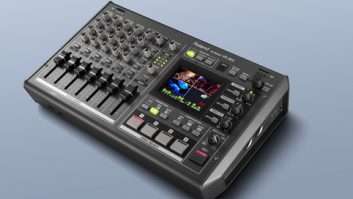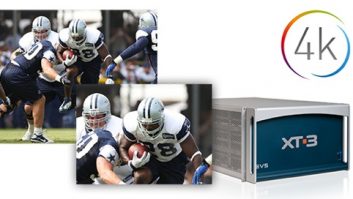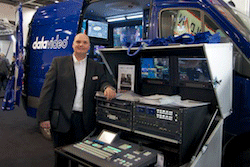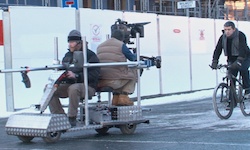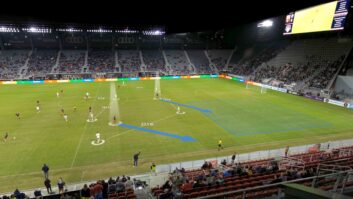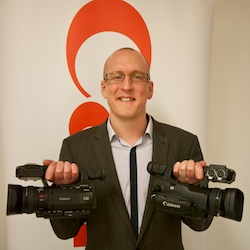
Canon shifts axis to 3D
Canon will be showing its new XF100 and XF105 cameras, plus the recently announced XA10 (making its European debut).
The XF105 is particularly interesting for its innovative 3D-friendly features, and a pair of them will be shown in the new Genus Hurricane rig designed by cameraman, Alister Chapman.
The XF105 is the same as the larger XF305 in terms of codec (50Mbps) and most controls, but Canon has added a few features that make it suitable for 3D.
It has screen inversion in any direction, to make it easier to use in a mirror rig (like the Hurricane); the zoom lens has a focal length guide, which allows users to set a reference point (the cameras aren’t fully synchronised although they have genlock/timecode synch), and as a numerical scale it offers a lot more precision when setting the two zooms manually so that both cameras are at the same focal length; there is also an Axis Shift Function. “This uses the lens shift from the Optical Image Stabilizer to keep the centre point of the image to a point you have chosen. It takes the cameras out of OIS mode, and uses the lens shift to keep that centre point throughout the zoom,” explained Peter Yabsley, Canon’s Business Development Manager, Professional Video, EMEA (pictured with two XF105s).
“You can also use it to fine tune the convergence of the cameras when you are shooting 3D. You can move the centre point more easily than actually moving the cameras,” which is useful in a manual rig like the Hurricane. Although the adjustments the XF105 allows are all manual, “it is intended to make the process easier” thanks to novel uses for technology already in the camera.
No other camera of this size, or indeed in this price range, has these features. “It is probably the smallest general purpose camcorder with genlock, and SDI, and a high quality codec,” he said. The XF100 and XF105 are due to start shipping shortly after the show. The XA10 should arrive in March.
www.canon-europe.com – Stand: E-34
JVC’s new GY-HM750 ProHD
JVC Professional will be showing its latest GY-HM750E ProHD compact shoulder-mount camcorder. It is claimed to offer “the industry’s fastest shoot-to-edit workflow by recording native HD or SD footage in ready-to-edit file formats on low-cost SDHC memory cards.”
It uses the same 3-CCD imaging system as the GY-HM790E, JVC’s ProHD flagship camcorder, and records HD in 720p, 1080p, and 1080i, as well as SD (576i) at selectable data rates up to 35Mbps.
It has a dual SDHC card slot design and can record to SD and/or an optional SxS recorder. It now allows simultaneous recording to both SDHC cards, for instant backup or client copy, which had been a common customer request.
Users can record in ready-to-edit file formats for Apple Final Cut Pro or Adobe Premiere (.mov), or as Sony XDCAM EX files (.MP4). For standard definition work, it can also record DV files (.avi or .mov).
Building on the modular approach of the GY-HM790E, the GY-HM750E includes a 68-pin chassis connector for a clean, direct interface to various modules. The new KA-AS790 ASI output module, for example, provides a direct feed from the camera to a satellite uplink or microwave transmitter via BNC, ideal for broadcasting live HD from the field. The GY-HM750E automatically switches to low-latency mode (less than 300ms delay) when the module is in use.
JVC has also improved its Pre Rec (cache) feature, which continuously records and stores footage in cache memory and helps prevent missed shots of breaking events, which now stores 20 seconds. Other features include variable frame rate recording, extensive image customisation, a high-resolution (1.22 million pixel) LCOS viewfinder and 4.3-inch flip-out LCD monitor, and JVC’s Focus Assist. It also has two XLR audio inputs with phantom power, plus manual audio level controls with an audio meter.
The GY-HM750E includes a Canon 14:1 zoom lens, but accommodates any lens with a 1/3-inch bayonet lens mount.
www.jvcpro.eu – Stand: C-30
Panasonic AF101 and 3D
Panasonic‘s new AG-AF101 large sensor camcorder is in high demand, thanks to the ability of its Micro Four Thirds sensor to produce shallow depth of field (it is four times the size of a broadcast 2/3-inch camera, although its focus won’t be as shallow as a Super 35mm sensor at the same lens settings).
It can be fitted with a wide range of lenses, including Zeiss Compact Primes and stills lenses via adaptors. Unlike HD DSLR cameras it has no visible aliasing or moiré effects, thanks to an optical filter that reduces the resolution of the sensor (to HD resolutions) and smoothes out any possible defects. It also has lots of video features, such as peaking, waveform display, various gamma modes, internal optical ND filters, uncompressed audio with XLR inputs, and timecode input/output, which are not typically available on DSLRs.
It records 24Mbps AVCHD onto SD cards, but has HD-SDI and HDMI outputs for 4:2:2 recording. There is also variable frame rate recording.
Also on show is the AG-3DA1 HD 3D camcorder. It has dual lenses and two sets of 1920×1080, 2.07 megapixel 3-MOS imagers. It also has dual 32GB SD cards and interfaces include dual HD-SDI outputs and HDMI (v1.4). It includes automatic correction for horizontal and vertical displacement allowing it to recalibrate without the need for external equipment, so that you can shoot 3D more easily.
www.panasonic-broadcast.com – Stand: K-30
Holdan demonstrates stereoscopic workflow
Also Panasonic related – Its UK distributor, Holdan will demonstrate a complete stereoscopic content creation workflow from camera to edited programme at an affordable price.
Its starting point is the AG-3DA1, feeding a HP Z400 workstation running Grass Valley’s Edius 6 – the full system costing less than £18,000.
Taking the dual HD-SDI feed from the camcorder will be a Blackmagic Design HDLink Pro Display Port 3D that converts the signals to side-by-side, field by field, top and bottom or frame-packed 3D formats. The editing system, based on an Intel Xeon HP workstation and Edius 6 will demonstrate 3D cutting techniques. Edius works natively with professional formats without the need for rendering or transcoding. This philosophy has been extended to stereoscopic, with support for synchronized left and right field editing built into the latest version (which costs less than £600).
The demonstration will also include a Grass Valley T2 hard disk recorder, playing out 3D signals (manually or from a playlist) so that users can display or project high quality 3D.
www.holdan.co.uk – Stand: I-10
Sony Super-sizes its sensors
BVE will be first UK public showing of the compact Sony PMW-F3 (pictured), its latest XDCAM EX camera with a newly designed Super 35mm Exmor CMOS sensor and versatile workflow options for high quality digital cinematography. It will be shown alongside other additions to its 35mm line up, such as the SRW-9000PL, its all-in-one HDCAM SR camcorder with a Super 35mm sensor and PL lens mount. 35mm Sensor and PL mount upgrades are also available for existing 2/3-inch SRW-9000 camcorders and both camcorders will also be upgradeable soon to SR Memory recording.
Other highlights include: the PMW-500, Sony’s first solid state XDCAM HD 422 camcorder; additions to its OLED monitor range to add to the new PVM-740 7.4-inch model; and for 3D, Sony will be showing its MPE-200 3D processor box and HDFA dual camera fibre technology.
There will also be free, daily Sony seminars in the Whitehall Room on 3D Live Production, 35mm World, OLED Monitoring Technology, XDCAM File Based Acquisition, and Professional Audio.
www.sonybiz.net – Stand I-20
Free Seminars
There will also be lots of free seminars, workshops and masterclasses at BVE, encompassing everything from 3D, shooting with DSLRs, tapeless workflow, online and mobile TV, to audio, post production, and how to make money in the business.
We’ll be there every day, with a seminar each morning at 10am in the Production Theatre: Production on a Budget, offering advice on how to choose camera equipment, on a budget, what features are important for different types of production, and helping you differentiate between all the new cameras on show. It will be presented by broadcast trainer, Christina Fox, www.urbanfox.tv, and David Fox.
www.bvexpo.co.uk
Canon shifts axis to 3D
Canon will be showing its new XF100 and XF105 cameras, plus the recently announced XA10 (making its European debut).
The XF105 is particularly interesting for its innovative 3D-friendly features, and a pair of them will be shown in the new Genus Hurricane rig designed by cameraman, Alister Chapman.
The XF105 is the same as the larger XF305 in terms of codec (50Mbps) and most controls, but Canon has added a few features that make it suitable for 3D.
It has screen inversion in any direction, to make it easier to use in a mirror rig (like the Hurricane); the zoom lens has a focal length guide, which allows users to set a reference point (the cameras aren’t fully synchronised although they have genlock/timecode synch), and as a numerical scale it offers a lot more precision when setting the two zooms manually so that both cameras are at the same focal length; there is also an Axis Shift Function. “This uses the lens shift from the Optical Image Stabilizer to keep the centre point of the image to a point you have chosen. It takes the cameras out of OIS mode, and uses the lens shift to keep that centre point throughout the zoom,” explained Peter Yabsley, Canon’s Business Development Manager, Professional Video, EMEA (pictured with two XF105s).
“You can also use it to fine tune the convergence of the cameras when you are shooting 3D. You can move the centre point more easily than actually moving the cameras,” which is useful in a manual rig like the Hurricane. Although the adjustments the XF105 allows are all manual, “it is intended to make the process easier” thanks to novel uses for technology already in the camera.
No other camera of this size, or indeed in this price range, has these features. “It is probably the smallest general purpose camcorder with genlock, and SDI, and a high quality codec,” he said. The XF100 and XF105 are due to start shipping shortly after the show. The XA10 should arrive in March.
www.canon-europe.com – Stand: E-34
JVC’s new GY-HM750 ProHD
JVC Professional will be showing its latest GY-HM750E ProHD compact shoulder-mount camcorder. It is claimed to offer “the industry’s fastest shoot-to-edit workflow by recording native HD or SD footage in ready-to-edit file formats on low-cost SDHC memory cards.”
It uses the same 3-CCD imaging system as the GY-HM790E, JVC’s ProHD flagship camcorder, and records HD in 720p, 1080p, and 1080i, as well as SD (576i) at selectable data rates up to 35Mbps.
It has a dual SDHC card slot design and can record to SD and/or an optional SxS recorder. It now allows simultaneous recording to both SDHC cards, for instant backup or client copy, which had been a common customer request.
Users can record in ready-to-edit file formats for Apple Final Cut Pro or Adobe Premiere (.mov), or as Sony XDCAM EX files (.MP4). For standard definition work, it can also record DV files (.avi or .mov).
Building on the modular approach of the GY-HM790E, the GY-HM750E includes a 68-pin chassis connector for a clean, direct interface to various modules. The new KA-AS790 ASI output module, for example, provides a direct feed from the camera to a satellite uplink or microwave transmitter via BNC, ideal for broadcasting live HD from the field. The GY-HM750E automatically switches to low-latency mode (less than 300ms delay) when the module is in use.
JVC has also improved its Pre Rec (cache) feature, which continuously records and stores footage in cache memory and helps prevent missed shots of breaking events, which now stores 20 seconds. Other features include variable frame rate recording, extensive image customisation, a high-resolution (1.22 million pixel) LCOS viewfinder and 4.3-inch flip-out LCD monitor, and JVC’s Focus Assist. It also has two XLR audio inputs with phantom power, plus manual audio level controls with an audio meter.
The GY-HM750E includes a Canon 14:1 zoom lens, but accommodates any lens with a 1/3-inch bayonet lens mount.
www.jvcpro.eu – Stand: C-30
Panasonic AF101 and 3D
Panasonic‘s new AG-AF101 large sensor camcorder is in high demand, thanks to the ability of its Micro Four Thirds sensor to produce shallow depth of field (it is four times the size of a broadcast 2/3-inch camera, although its focus won’t be as shallow as a Super 35mm sensor at the same lens settings).
It can be fitted with a wide range of lenses, including Zeiss Compact Primes and stills lenses via adaptors. Unlike HD DSLR cameras it has no visible aliasing or moiré effects, thanks to an optical filter that reduces the resolution of the sensor (to HD resolutions) and smoothes out any possible defects. It also has lots of video features, such as peaking, waveform display, various gamma modes, internal optical ND filters, uncompressed audio with XLR inputs, and timecode input/output, which are not typically available on DSLRs.
It records 24Mbps AVCHD onto SD cards, but has HD-SDI and HDMI outputs for 4:2:2 recording. There is also variable frame rate recording.
Also on show is the AG-3DA1 HD 3D camcorder. It has dual lenses and two sets of 1920×1080, 2.07 megapixel 3-MOS imagers. It also has dual 32GB SD cards and interfaces include dual HD-SDI outputs and HDMI (v1.4). It includes automatic correction for horizontal and vertical displacement allowing it to recalibrate without the need for external equipment, so that you can shoot 3D more easily.
www.panasonic-broadcast.com – Stand: K-30
Holdan demonstrates stereoscopic workflow
Also Panasonic related – Its UK distributor, Holdan will demonstrate a complete stereoscopic content creation workflow from camera to edited programme at an affordable price.
Its starting point is the AG-3DA1, feeding a HP Z400 workstation running Grass Valley’s Edius 6 – the full system costing less than £18,000.
Taking the dual HD-SDI feed from the camcorder will be a Blackmagic Design HDLink Pro Display Port 3D that converts the signals to side-by-side, field by field, top and bottom or frame-packed 3D formats. The editing system, based on an Intel Xeon HP workstation and Edius 6 will demonstrate 3D cutting techniques. Edius works natively with professional formats without the need for rendering or transcoding. This philosophy has been extended to stereoscopic, with support for synchronized left and right field editing built into the latest version (which costs less than £600).
The demonstration will also include a Grass Valley T2 hard disk recorder, playing out 3D signals (manually or from a playlist) so that users can display or project high quality 3D.
www.holdan.co.uk – Stand: I-10
Sony Super-sizes its sensors
BVE will be first UK public showing of the compact Sony PMW-F3 (pictured), its latest XDCAM EX camera with a newly designed Super 35mm (APS-C size) Exmor CMOS sensor and versatile workflow options for high quality digital cinematography. It will be shown alongside other additions to its 35mm line up, such as the SRW-9000PL, its all-in-one HDCAM SR camcorder with a Super 35mm sensor and PL lens mount. 35mm Sensor and PL mount upgrades are also available for existing 2/3-inch SRW-9000 camcorders and both camcorders will also be upgradeable soon to SR Memory recording.
Other highlights include: the PMW-500, Sony’s first solid state XDCAM HD 422 camcorder; additions to its OLED monitor range to add to the new PVM-740 7.4-inch model; and for 3D, Sony will be showing its MPE-200 3D processor box and HDFA dual camera fibre technology.
There will also be free, daily Sony seminars in the Whitehall Room on 3D Live Production, 35mm World, OLED Monitoring Technology, XDCAM File Based Acquisition, and Professional Audio.
www.sonybiz.net – Stand I-20
Free Seminars
There will also be lots of free seminars, workshops and masterclasses at BVE, encompassing everything from 3D, shooting with DSLRs, tapeless workflow, online and mobile TV, to audio, post production, and how to make money in the business.
We’ll be there every day, with a seminar each morning at 10am in the Production Theatre: Production on a Budget, offering advice on how to choose camera equipment, on a budget, what features are important for different types of production, and helping you differentiate between all the new cameras on show. It will be presented by broadcast trainer, Christina Fox, www.urbanfox.tv, and David Fox.
